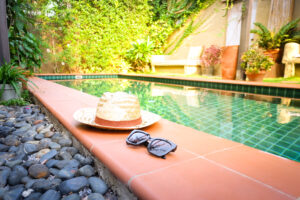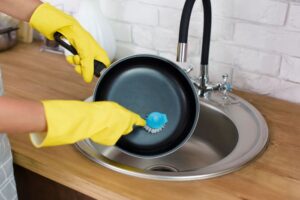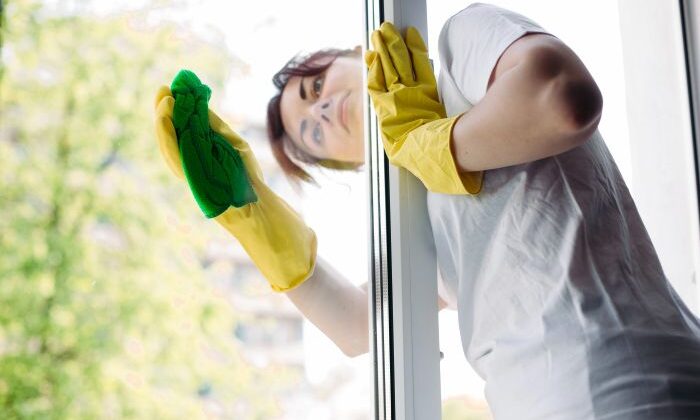Having your own pool in the garden is a dream for many homeowners. It not only offers a welcome way to cool off on hot summer days, but also a place of relaxation and enjoyment for the whole family. But to enjoy swimming to the fullest, you should clean your pool regularly. A clean pool not only looks good, it is also crucial for the health of the bathers.
Whether you have an in-ground pool or an above-ground inflatable pool, this blog has collected practical tips and best practices to help you keep your pool in tip-top condition. From daily care to special cleaning techniques, we’ll give you all the tools you need to keep water quality high and pool maintenance simple and effective.
Dive into our comprehensive guide and learn how to best care for your pool to ensure a clean and safe swimming experience at all times.
Cleaning the pool: tips and tricks for a clean water surface

If you own a pool, you know how important it is to keep it clean. A clean pool not only looks better, but it is also more hygienic and safer for swimmers. So cleaning your pool should be part of your basic summer cleaning routine!
First of all, it is important to regularly check the pH of the water and adjust it if necessary. A pH between 7.2 and 7.6 is ideal for a pool. You can use pH test strips to measure the pH and use pH regulators to adjust it.
Another important factor is filtration. The pool filter should be cleaned regularly to ensure that it is working effectively. Depending on the type and size of the pool, it may be a good idea to clean the filter daily or weekly. Below we have collected the best tips and tricks for you so that you do not fall victim to summer cleaning myths that are often circulating.
Basics of Pool Care
To ensure your pool stays clean and hygienic, there are some pool maintenance basics you should keep in mind:
- Check the pH of the water: The pH of the water should be between 7.2 and 7.8 to ensure that the water is not too acidic or too alkaline. Use a pH tester to check the pH of the water and adjust it if necessary.
- Clean the skimmer basket: The skimmer basket catches leaves, twigs and other debris before they reach the filter. Empty the skimmer basket regularly to make sure it is not clogged.
- Use a pool cleaner: A pool cleaner can help keep your pool clean by removing contaminants such as leaves, dirt and insects from the water. There are several types of pool cleaners available, including automatic and manual models.
- Clean the filter: The filter is an important part of the pool cleaning system and removes dirt, bacteria and other contaminants from the water. Clean the filter regularly to ensure it is working effectively.
- Use chlorine: Chlorine is a commonly used disinfectant that helps kill bacteria, algae and other contaminants in the water. Use chlorine in the recommended amount to ensure your pool stays sanitary.
Necessary cleaning agents and tools
To keep your pool clean, you will need some cleaning supplies and tools. We have put together a list of the most important things for you:
pool chemicals
- Chlorine: A disinfectant that kills bacteria and algae.
- pH regulator: An agent that stabilizes the pH value of the water.
- Algaecide: A product that kills algae and prevents it from spreading in the pool.
- Shock treatment agent: An agent that rapidly increases chlorine levels to kill bacteria and algae.
cleaning equipment
- Pool brush: A brush that you can use to clean the pool floor and walls.
- Pool net: A net that you can use to remove leaves, insects and other debris from the pool.
- Pool vacuum cleaner: A device that allows you to vacuum the pool floor and walls.
Personal protective equipment
- Gloves: Protect your hands from chemicals.
- Safety glasses: Protect your eyes from chemicals.
- Respirator: Protect your lungs from chemicals.
Regular cleaning routines

If you own a pool, it is important to perform regular cleaning routines to ensure the water remains clean and hygienic:
1. Surface cleaning
The surface of your pool should be cleaned regularly of leaves, insects and other debris using a net or skimmer. If you use the skimmer, make sure it is clean to ensure optimal cleaning.
2. Scrub the floor and walls
It is also important to scrub the floor and walls of your pool regularly to remove debris and dirt. To do this, you should use a brush that is suitable for your pool floor. Avoid hard brushes that can damage the pool floor or cause scratches.
3. Filter cleaning
Your pool filter is an important part of your cleaning routine. Make sure you clean the filter regularly to avoid clogging. The frequency of cleaning depends on the size of your pool and the type of filter. Check your filter’s instructions to find out how often it should be cleaned.
Cleaning the different pool types
When it comes to pool cleaning, it’s important to consider the specific needs of different pool types. Above ground pools and inground pools each have their own challenges and require different approaches to keep them clean and well-maintained.
- Above ground pools are generally easier to install and maintain, but require regular maintenance to extend their lifespan and maintain water quality. It is especially important to check and clean the filter and pump regularly to ensure they are working effectively. You should also vacuum the pool floor and walls frequently to remove dirt and debris. A pool cover is also recommended to protect the pool from contamination when it is not in use.
- In-ground pools often require more intensive maintenance as they are more susceptible to algae growth and dirt. In addition to regularly vacuuming the pool floor and walls, you should also continuously monitor the water quality and add chemicals if necessary to keep the pH and chlorine levels in balance. Good water circulation is crucial, so the pump should run for several hours every day. It is also advisable to carry out a thorough deep cleaning once a year to rid the pool of stubborn deposits.
deep cleaning and algae control

When it comes to keeping your pool clean, deep cleaning and algae control is an important step. Here are some tips on how to deep clean your pool and remove algae.
shock chlorination
Shock chlorination is an effective way to deep clean your pool. This process involves adding a large amount of chlorine to the pool to kill bacteria and algae. To perform shock chlorination, you should carefully follow the instructions on the chlorine product’s packaging. Don’t forget to check and adjust the pool’s pH before performing shock chlorination.
algae removal
Algae can be a big problem in your pool. To remove algae, you should first check the pH of the pool and make sure it is between 7.2 and 7.8. Then you should use an algae remover that suits your pool type. Follow the instructions on the product’s packaging carefully to make sure you use it correctly.
If you have persistent algae problems, it may be necessary to drain your pool and clean it thoroughly. Don’t forget to refill the pool with fresh water and adjust the pH after cleaning.
Maintain water chemistry
When it comes to the cleanliness and hygiene of your pool, water chemistry is an important component. So, to ensure that your pool stays clean and healthy, it is important to maintain water chemistry.
pH adjustment
Der pH-Wert des Poolwassers sollte zwischen 7,2 und 7,8 liegen. Wenn der pH-Wert zu niedrig ist, kann dies zu Augenreizungen und Korrosion führen. Wenn der pH-Wert zu hoch ist, kann dies zu Kalkablagerungen und einer ineffektiven Chlorierung führen. Verwenden Sie einen pH-Tester, um den pH-Wert zu messen, und fügen Sie gegebenenfalls pH-Plus oder pH-Minus hinzu, um den pH-Wert zu korrigieren.
Chlorierung
Chlor tötet Bakterien und Algen ab und hält das Poolwasser sauber und klar. Der ideale Chlorwert liegt zwischen 1,0 und 3,0 ppm (Teile pro Million). Verwenden Sie einen Chlor-Tester, um den Chlorwert zu messen, und fügen Sie gegebenenfalls Chlor hinzu, um den Wert aufrechtzuerhalten. Es gibt verschiedene Arten von Chlorprodukten, einschließlich Granulat, Tabletten und Flüssigchlor.
Alkalinität und Härte
Die Alkalinität des Poolwassers sollte zwischen 80 und 120 ppm liegen, während die Härte zwischen 200 und 400 ppm liegen sollte. Eine optimale Alkalinität und Härte sorgt für eine bessere Wasserqualität und verhindert Korrosion. Verwenden Sie einen Alkalitäts- und Härte-Tester, um die Werte zu messen, und fügen Sie gegebenenfalls Alkalitätserhöher oder Härteerhöher hinzu, um die Werte zu korrigieren.
Winterfestmachung und Saisonvorbereitung

Nachdem Sie Ihren Pool für den Sommer gereinigt haben, sollten Sie nicht vergessen Ihren Pool nach der Saison für den Winter vorzubereiten. Denn mit den richtigen Vorkehrungen können Sie die Reinigung zu Saisonbeginn im kommenden Jahr minimieren.
Eine Poolabdeckung ist ein wichtiger Bestandteil der Winterfestmachung Ihres Pools, da sie das Wasser vor Schmutz und Verunreinigungen schützt und den Wärmeverlust reduziert. Es gibt verschiedene Arten von Poolabdeckungen wie Winterabdeckungen, Sicherheitsabdeckungen und Solarabdeckungen. Winterabdeckungen bieten optimalen Schutz vor Schnee, Eis und Laub und bestehen aus strapazierfähigem Material. Sicherheitsabdeckungen sind ideal für Haushalte mit Kindern oder Haustieren, da sie robust genug sind, um das Gewicht mehrerer Personen zu tragen. Solarabdeckungen nutzen die Sonnenenergie, um das Wasser umweltfreundlich zu erwärmen. Die Winterpflege Ihres Pools ist essenziell, um Algenwachstum und andere Probleme zu vermeiden. Dazu gehört das regelmäßige Überprüfen des pH-Werts und des Chlorgehalts, die Verwendung eines Winterpflege-Kits, das Entfernen von Blättern und Schmutz von der Poolabdeckung sowie die Überprüfung der Poolausrüstung. Außerdem sollten Sie den Skimmer und die Pumpe entleeren und an einem trockenen Ort lagern und gegebenenfalls eine Poolheizung verwenden, um das Wasser warm zu halten und Frostschäden zu verhindern. Durch diese Maßnahmen bleibt Ihr Pool während der Wintermonate geschützt und in gutem Zustand.
Fazit
Die Pflege Ihres Pools ist entscheidend, um einen sicheren und angenehmen Badeplatz für Ihre Familie zu gewährleisten. Durch regelmäßige Reinigung und Wartung können Sie die Wasserqualität hochhalten und die Lebensdauer Ihres Pools verlängern. Egal, ob Sie einen oberirdischen oder unterirdischen Pool besitzen, die richtigen Werkzeuge und Chemikalien, sowie tägliche, wöchentliche und saisonale Pflegeroutinen sind unerlässlich. Mit den in diesem Blog bereitgestellten Tipps und Tricks können Sie sicherstellen, dass Ihr Pool immer in bestem Zustand bleibt. Sollten Sie sich dennoch überfordert fühlen, kann die Inanspruchnahme professioneller Poolreinigungs- und Wartungsdienste eine sinnvolle Lösung sein. So genießen Sie und Ihre Familie stets ein sauberes und sicheres Badeerlebnis.
Häufig gestellte Fragen
Wie reinigt man am besten einen Pool?
Die beste Art, einen Pool zu reinigen, ist durch regelmäßige Pflege. Sie sollten Ihren Pool mindestens einmal pro Woche reinigen, indem Sie Blätter, Schmutz und andere Ablagerungen von der Wasseroberfläche entfernen. Verwenden Sie einen Poolreiniger, um den Boden und die Wände des Pools zu reinigen. Achten Sie darauf, dass Sie den pH-Wert des Wassers im Auge behalten, um sicherzustellen, dass er im optimalen Bereich bleibt.
Wie kriegt man den Boden vom Pool sauber?
Um den Boden des Pools sauber zu halten, ist es am besten, regelmäßig zu reinigen. Verwenden Sie einen Poolreiniger oder einen Poolstaubsauger, um Ablagerungen und Schmutz vom Boden zu entfernen. Sie können auch eine Poolbürste verwenden, um hartnäckigen Schmutz zu entfernen. Stellen Sie sicher, dass Sie den pH-Wert des Wassers im Auge behalten, um sicherzustellen, dass er im optimalen Bereich bleibt.
Wie bekomme ich den Dreck aus dem Pool?
Um den Dreck aus dem Pool zu entfernen, sollten Sie regelmäßig reinigen und sicherstellen, dass der pH-Wert des Wassers im optimalen Bereich bleibt. Verwenden Sie einen Poolreiniger oder einen Poolstaubsauger, um Ablagerungen und Schmutz vom Boden und den Wänden des Pools zu entfernen. Sie können auch eine Poolbürste verwenden, um hartnäckigen Schmutz zu entfernen. Verwenden Sie eine Poolpumpe, um das Wasser zu zirkulieren und Schmutz und Ablagerungen zu entfernen.
Wie kann ich nach dem Winter meinen Pool reinigen?
Um Ihren Pool nach dem Winter wieder sauber zu machen, sollten Sie ihn gründlich reinigen und den pH-Wert des Wassers im Auge behalten. Entfernen Sie Blätter, Schmutz und andere Ablagerungen von der Wasseroberfläche und reinigen Sie den Boden und die Wände des Pools mit einem Poolreiniger oder einem Poolstaubsauger. Stellen Sie sicher, dass Sie den pH-Wert des Wassers im optimalen Bereich halten, um sicherzustellen, dass Ihr Pool sauber und sicher ist.
Welche Hausmittel eignen sich zur Poolreinigung?
There are several home remedies that can be used to clean pools. Some of these include vinegar, baking soda, and citric acid. These can be used to remove debris and dirt from the water surface and walls of the pool. However, it is important to note that home remedies are not always as effective as specialized pool cleaners.
How can I effectively prevent and remove algae growth in the pool?
To effectively prevent and remove algae growth in the pool, you should clean regularly and keep an eye on the pH level of the water. Use an algae remover to remove algae and add chlorine regularly to prevent algae growth. Make sure you keep the pH level of the water in the optimal range to ensure your pool is clean and safe.








